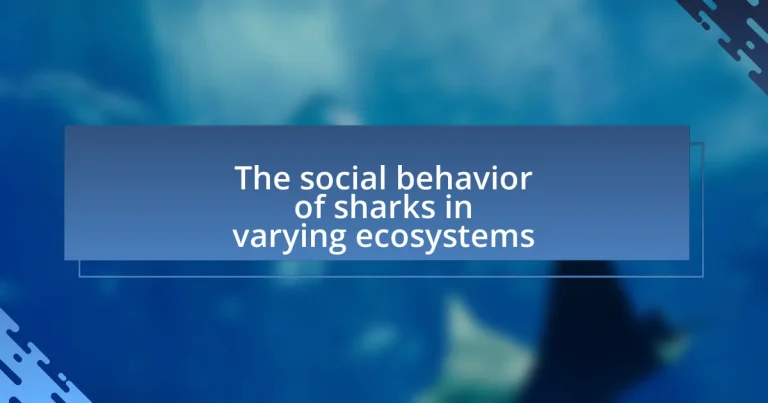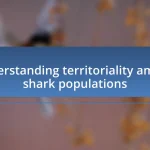The article examines the social behavior of sharks across various ecosystems, highlighting how environmental factors influence their interactions and group dynamics. It discusses the differences between coastal and open ocean habitats, where species like the blacktip reef shark exhibit schooling behavior for foraging and protection, while great white sharks tend to be solitary. The article also explores the implications of shark social structures on biodiversity, conservation strategies, and the ecological roles sharks play as apex predators. Additionally, it addresses the communication methods sharks use within their social groups, including body language and chemical signals, and emphasizes the importance of understanding these behaviors for effective conservation efforts.
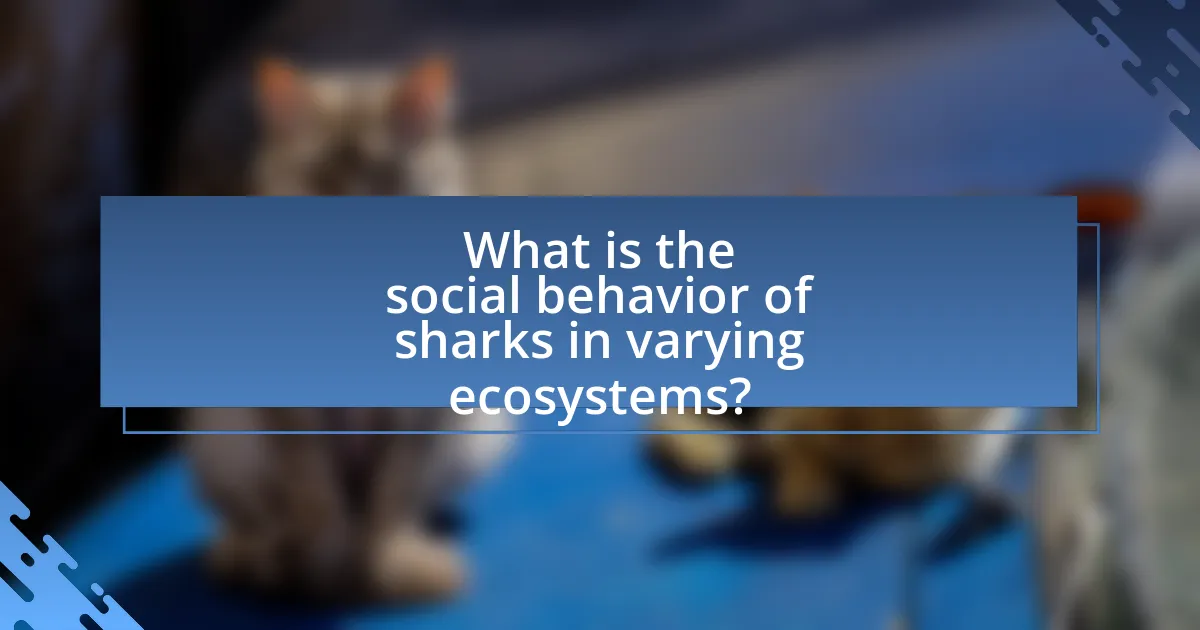
What is the social behavior of sharks in varying ecosystems?
Sharks exhibit diverse social behaviors that vary significantly across different ecosystems. In coastal environments, species such as the blacktip reef shark often form schools, demonstrating social structures that facilitate foraging and protection against predators. Conversely, in open ocean ecosystems, many shark species, like the great white shark, tend to be solitary, relying on their size and hunting prowess to survive. Research indicates that social interactions among sharks can also be influenced by environmental factors such as prey availability and habitat complexity, with studies showing that increased prey density can lead to more social behavior, as observed in the lemon shark populations in the Bahamas.
How do different ecosystems influence shark social behavior?
Different ecosystems significantly influence shark social behavior by dictating their interactions, group dynamics, and territoriality. In coastal ecosystems, such as coral reefs, sharks often exhibit more social behaviors, forming schools for hunting and protection, as seen in species like the blacktip reef shark. Conversely, in open ocean ecosystems, sharks tend to be more solitary, with species like the great white shark displaying territorial behavior and less social interaction. Research indicates that environmental factors, such as prey availability and habitat structure, directly impact these behaviors; for instance, areas with abundant prey lead to increased social interactions among sharks.
What are the key ecosystems where sharks are found?
Sharks are primarily found in marine ecosystems, including coral reefs, open oceans, and coastal areas. Coral reefs provide essential habitats for many shark species, offering shelter and abundant prey. Open oceans serve as migratory pathways and feeding grounds for larger shark species, while coastal areas, such as estuaries and bays, are crucial for nursery habitats where juvenile sharks can grow and develop. These ecosystems support diverse shark populations, highlighting their adaptability and ecological significance.
How does the environment shape shark interactions?
The environment significantly shapes shark interactions by influencing their behavior, social structures, and feeding patterns. For instance, in coastal ecosystems, sharks often exhibit more social behavior due to the presence of abundant prey and structured habitats, such as reefs, which facilitate interactions among individuals. Research indicates that species like the blacktip reef shark engage in social hunting in these environments, enhancing their foraging success. Additionally, environmental factors such as water temperature, salinity, and habitat complexity can affect shark distribution and interactions; for example, warmer waters may lead to increased aggregation of certain species, promoting social interactions. These dynamics are supported by studies showing that environmental conditions directly correlate with the frequency and type of interactions observed among shark populations.
Why is understanding shark social behavior important?
Understanding shark social behavior is important because it informs conservation strategies and enhances our knowledge of marine ecosystems. Sharks exhibit complex social interactions that influence their hunting strategies, reproductive success, and overall population dynamics. Research indicates that species such as the great white shark and the hammerhead shark display social structures that can affect their survival rates and ecological roles. For instance, studies have shown that social behavior can lead to increased foraging efficiency and improved mating opportunities, which are critical for maintaining healthy shark populations. Understanding these dynamics is essential for effective management and protection of shark species, particularly in the face of threats like overfishing and habitat loss.
What role do sharks play in marine ecosystems?
Sharks play a crucial role as apex predators in marine ecosystems, helping to maintain the balance of marine life. By preying on various species, sharks regulate fish populations, which in turn supports the health of coral reefs and other habitats. For instance, studies have shown that the removal of sharks can lead to an overpopulation of herbivorous fish, resulting in the overgrazing of seagrass and coral, which diminishes biodiversity. This ecological balance is essential for the resilience of marine ecosystems, highlighting the importance of sharks in sustaining marine biodiversity and ecosystem health.
How does shark social behavior impact biodiversity?
Shark social behavior significantly impacts biodiversity by influencing the population dynamics of prey species and the overall health of marine ecosystems. Social structures among sharks, such as schooling or solitary behaviors, can affect their hunting efficiency and reproductive success, which in turn shapes the abundance and diversity of marine life. For instance, studies have shown that when sharks are present in higher densities, they can regulate the populations of smaller fish and invertebrates, preventing overgrazing of seagrass and coral reef habitats. This trophic control helps maintain ecological balance and promotes greater species diversity within these ecosystems.
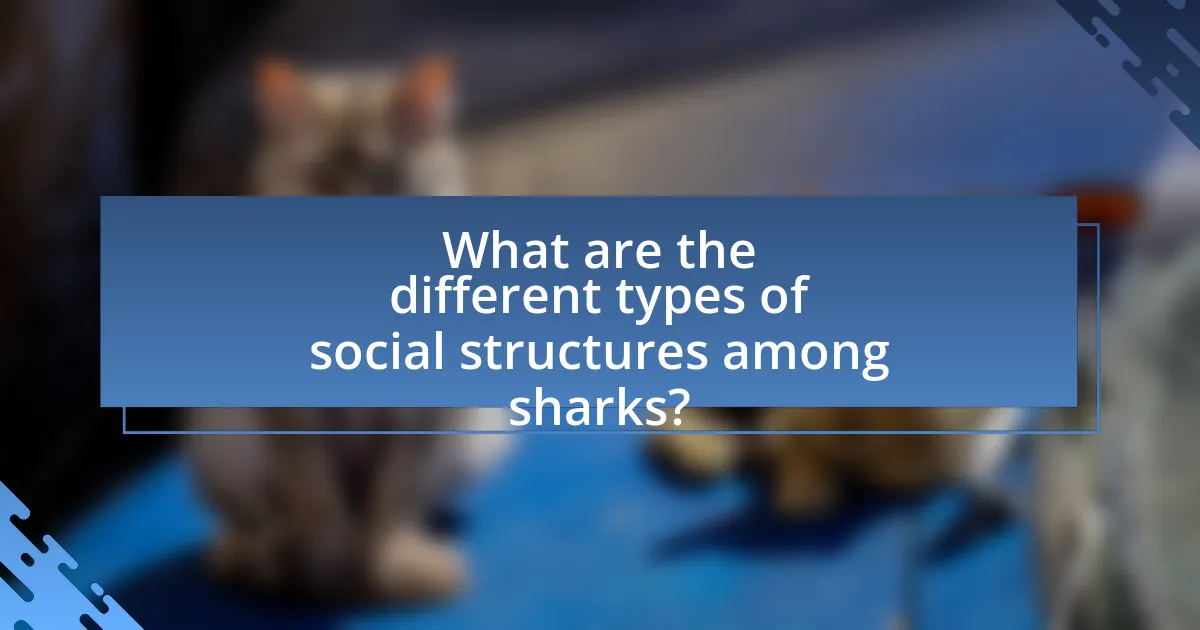
What are the different types of social structures among sharks?
Sharks exhibit various social structures, primarily categorized into solitary, social, and schooling behaviors. Solitary sharks, such as the great white shark, typically hunt and live alone, relying on stealth and individual hunting strategies. Social sharks, like the hammerhead, often form loose groups for mating or protection, demonstrating social interactions without a strict hierarchy. Schooling behavior is observed in species like the blacktip reef shark, where individuals swim in coordinated groups, enhancing foraging efficiency and reducing predation risk. These social structures are influenced by ecological factors, such as prey availability and environmental conditions, which dictate the social dynamics and interactions among different shark species.
How do solitary and social behaviors manifest in sharks?
Sharks exhibit both solitary and social behaviors, with solitary species often hunting alone and social species forming groups for activities such as hunting or mating. For instance, species like the great white shark tend to be solitary, relying on stealth and individual hunting strategies, while species such as the hammerhead shark are known to form schools, which can enhance their foraging efficiency and provide protection from predators. Research indicates that social interactions among sharks can lead to increased success in hunting, as seen in studies where groups of hammerhead sharks coordinated their movements to herd prey.
What species of sharks are known for social behavior?
Species of sharks known for social behavior include the hammerhead shark, particularly the great hammerhead, and the blacktip reef shark. Hammerhead sharks often form schools, especially during mating seasons, demonstrating social structures and cooperative behaviors. Blacktip reef sharks are also observed in groups, exhibiting social interactions while hunting and resting. Research indicates that these species engage in complex social dynamics, which can enhance their survival and reproductive success in various ecosystems.
How do social structures vary among different shark species?
Social structures among different shark species vary significantly, influenced by factors such as species behavior, habitat, and social interactions. For instance, species like the hammerhead shark exhibit schooling behavior, often forming large groups for hunting and protection, while solitary species like the great white shark tend to be more territorial and prefer to hunt alone. Research indicates that social structures can also be influenced by environmental conditions; for example, in areas with abundant food, some species may form temporary aggregations, while in less resource-rich environments, they may revert to solitary behavior. These variations highlight the adaptability of sharks to their ecosystems and the importance of social structures in their survival and reproductive strategies.
What factors contribute to the formation of shark groups?
Shark groups, or schools, form primarily due to factors such as foraging efficiency, predator avoidance, and social interaction. Foraging efficiency is enhanced when sharks hunt in groups, as they can coordinate their movements to herd prey, making it easier to capture food. Predator avoidance is another significant factor; by grouping together, sharks can reduce individual risk of predation, as larger groups can deter potential threats. Social interaction also plays a role, as certain species exhibit social behaviors that encourage group formation, such as mating rituals or cooperative hunting strategies. Research has shown that species like the blacktip reef shark often form schools for these reasons, demonstrating the importance of social structures in their behavior and survival.
How does prey availability influence shark grouping behavior?
Prey availability significantly influences shark grouping behavior, as sharks tend to form larger groups in areas where prey is abundant. This behavior is driven by the need for efficient foraging; when prey is plentiful, sharks can benefit from cooperative hunting strategies and increased success rates in capturing food. Research has shown that species such as the blacktip reef shark exhibit increased social interactions and group formations in response to high prey density, which enhances their foraging efficiency and survival rates.
What environmental factors affect shark social interactions?
Environmental factors that affect shark social interactions include water temperature, salinity, and habitat structure. Water temperature influences metabolic rates and reproductive cycles, which can affect social behaviors such as mating and territoriality. Salinity levels can impact the distribution of prey species, thereby influencing shark congregation patterns. Habitat structure, such as the presence of reefs or kelp forests, provides shelter and foraging opportunities, facilitating social interactions among sharks. Research indicates that these factors can significantly alter the dynamics of shark communities, as evidenced by studies showing variations in social behavior in different environmental conditions.
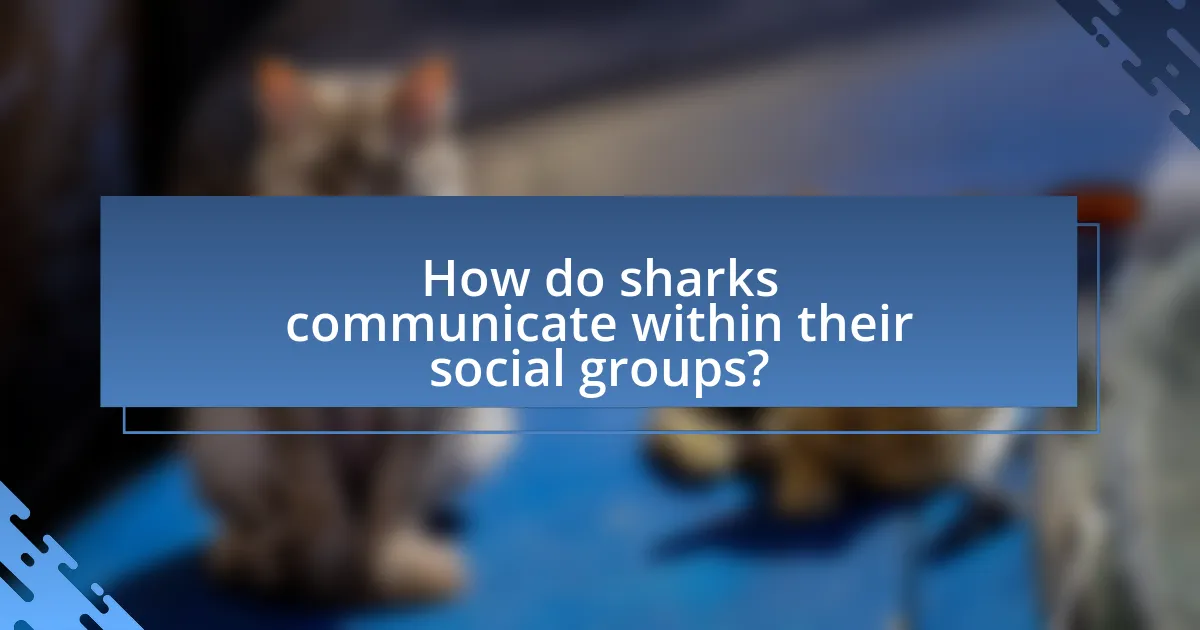
How do sharks communicate within their social groups?
Sharks communicate within their social groups primarily through body language, chemical signals, and vocalizations. Body language includes postures and movements that convey aggression, submission, or readiness to mate, which are crucial for maintaining social hierarchies and interactions. Chemical communication occurs through the release of pheromones, which can signal reproductive status or territorial boundaries. Additionally, some species of sharks produce sounds, such as grunts or clicks, which may serve as a form of communication during social interactions. Research indicates that these methods of communication are essential for coordinating group behavior and enhancing social bonds among sharks, particularly in species that exhibit more complex social structures, such as the hammerhead shark.
What methods do sharks use to communicate with each other?
Sharks communicate with each other primarily through body language, chemical signals, and sounds. Body language includes posturing and movements that convey aggression, submission, or readiness to mate. For instance, a shark may arch its back or display its fins to signal dominance. Chemical communication occurs through the release of pheromones, which can indicate reproductive status or territorial boundaries. Additionally, sharks can produce sounds by grinding their teeth or using their swim bladders, which may serve to attract mates or deter rivals. Research has shown that these methods are crucial for social interactions and maintaining hierarchies within shark populations, highlighting their complex social behavior in various ecosystems.
How do visual signals play a role in shark communication?
Visual signals are crucial in shark communication, as they facilitate interactions among individuals, particularly during social behaviors such as mating and territorial displays. Sharks utilize body postures, fin movements, and coloration changes to convey information about their intentions and emotional states. For instance, a shark may arch its back and elevate its dorsal fin to signal aggression or dominance, while a relaxed posture can indicate submission or non-threat. Research has shown that these visual cues are essential for maintaining social hierarchies and coordinating group behaviors, particularly in species like the blacktip reef shark, which exhibit complex social structures.
What role does body language have in shark interactions?
Body language plays a crucial role in shark interactions by facilitating communication and social behavior among individuals. Sharks utilize various postures, movements, and fin positions to convey messages related to aggression, submission, or mating readiness. For instance, a shark that arches its back and raises its dorsal fin may be signaling aggression, while a relaxed posture with a lowered fin can indicate submission or non-threat. Research has shown that these non-verbal cues are essential for maintaining social hierarchies and reducing conflict within groups, as evidenced by studies observing species like the blacktip reef shark, which exhibit distinct body language during social interactions.
How does communication affect shark social dynamics?
Communication significantly influences shark social dynamics by facilitating interactions that establish hierarchies and mating behaviors. Sharks utilize various forms of communication, including body language, chemical signals, and vocalizations, to convey information about territory, reproductive status, and social relationships. For instance, studies have shown that the presence of pheromones can trigger specific social responses, such as attracting mates or signaling dominance. Additionally, visual cues, like posturing and fin displays, help sharks navigate social structures within their groups, impacting their feeding strategies and reproductive success. These communication methods are essential for maintaining social order and enhancing survival in diverse marine environments.
What impact does communication have on hunting strategies?
Communication significantly enhances hunting strategies among sharks by facilitating coordinated group behavior. Sharks utilize various forms of communication, such as body language and acoustic signals, to share information about prey location and movement. For instance, studies have shown that species like the blacktip reef shark exhibit synchronized hunting techniques, which increase their success rate in capturing schools of fish. This coordinated effort is supported by research indicating that social interactions among sharks lead to improved foraging efficiency, as evidenced by increased catch rates when hunting in groups compared to solitary efforts.
How does communication influence mating behaviors in sharks?
Communication significantly influences mating behaviors in sharks by facilitating mate recognition and courtship interactions. Sharks utilize a combination of visual signals, chemical cues, and body language to communicate their reproductive status and intentions. For instance, during mating season, male sharks often engage in behaviors such as circling and nipping at females, which are forms of visual and tactile communication that indicate interest. Research has shown that these behaviors are crucial for successful mating, as they help establish dominance hierarchies and ensure that females can select suitable mates. Additionally, chemical signals released by females can attract males from considerable distances, further enhancing mating opportunities. This multi-modal communication system is essential for reproductive success in various shark species, as evidenced by studies observing mating rituals in species like the blacktip reef shark and the great white shark.
What are the implications of shark social behavior for conservation efforts?
Shark social behavior significantly influences conservation efforts by highlighting the need for habitat protection and species-specific management strategies. Research indicates that sharks exhibit complex social structures, such as forming groups or schools, which can affect their reproductive success and foraging efficiency. For instance, studies have shown that species like the blacktip reef shark engage in social behaviors that enhance their survival rates, suggesting that preserving their social environments is crucial for maintaining healthy populations. Additionally, understanding these social dynamics can inform targeted conservation initiatives, such as establishing marine protected areas that cater to the social needs of different shark species, ultimately leading to more effective conservation outcomes.
How can understanding shark social behavior aid in their protection?
Understanding shark social behavior can significantly aid in their protection by informing conservation strategies that align with their natural interactions and habitats. Research indicates that sharks exhibit complex social structures, such as forming schools or exhibiting social hierarchies, which can influence their vulnerability to fishing and habitat degradation. For instance, studies have shown that species like the blacktip reef shark engage in social behaviors that enhance their survival, such as cooperative hunting and social learning. By recognizing these behaviors, conservationists can implement targeted protection measures, such as establishing marine protected areas that consider these social dynamics, ultimately leading to more effective preservation of shark populations.
What strategies can be implemented to conserve shark populations?
To conserve shark populations, implementing marine protected areas (MPAs) is essential. MPAs restrict fishing and habitat destruction, allowing shark populations to recover and thrive. Research indicates that areas with strong protections can see shark populations increase by up to 50% within a few years, as demonstrated by studies conducted in the Caribbean and Pacific regions. Additionally, enforcing sustainable fishing practices, such as catch limits and gear restrictions, can significantly reduce bycatch and overfishing, which are major threats to sharks. For instance, the implementation of the Shark Conservation Act in the United States has led to a decrease in shark finning and improved population stability. Lastly, public awareness campaigns can educate communities about the ecological importance of sharks, fostering support for conservation initiatives.
What practical insights can be gained from studying shark social behavior?
Studying shark social behavior provides practical insights into their ecological roles and conservation strategies. Understanding how sharks interact socially can inform management practices, as social structures influence their movement patterns and habitat use. For instance, research has shown that species like the blacktip reef shark exhibit social hierarchies that affect their foraging efficiency and reproductive success. This knowledge can guide the establishment of marine protected areas, ensuring that critical habitats are preserved to support these social dynamics. Additionally, insights into social behavior can enhance public awareness and education efforts, fostering community support for shark conservation initiatives.
